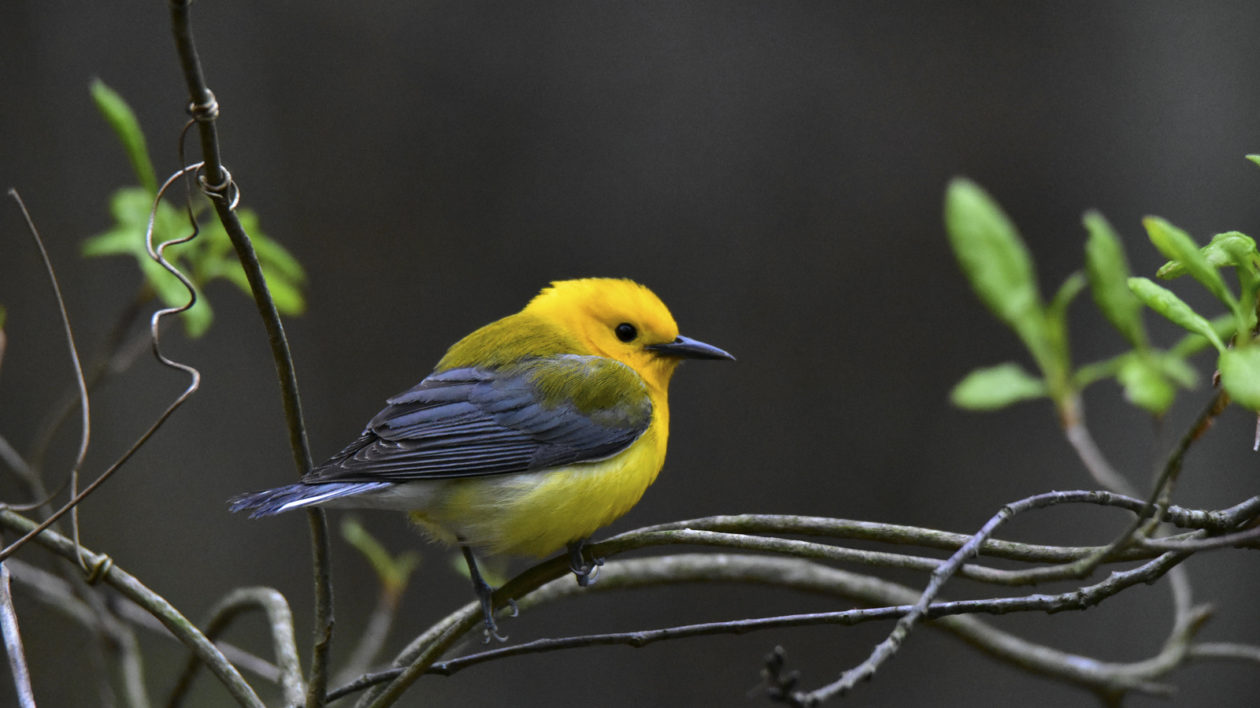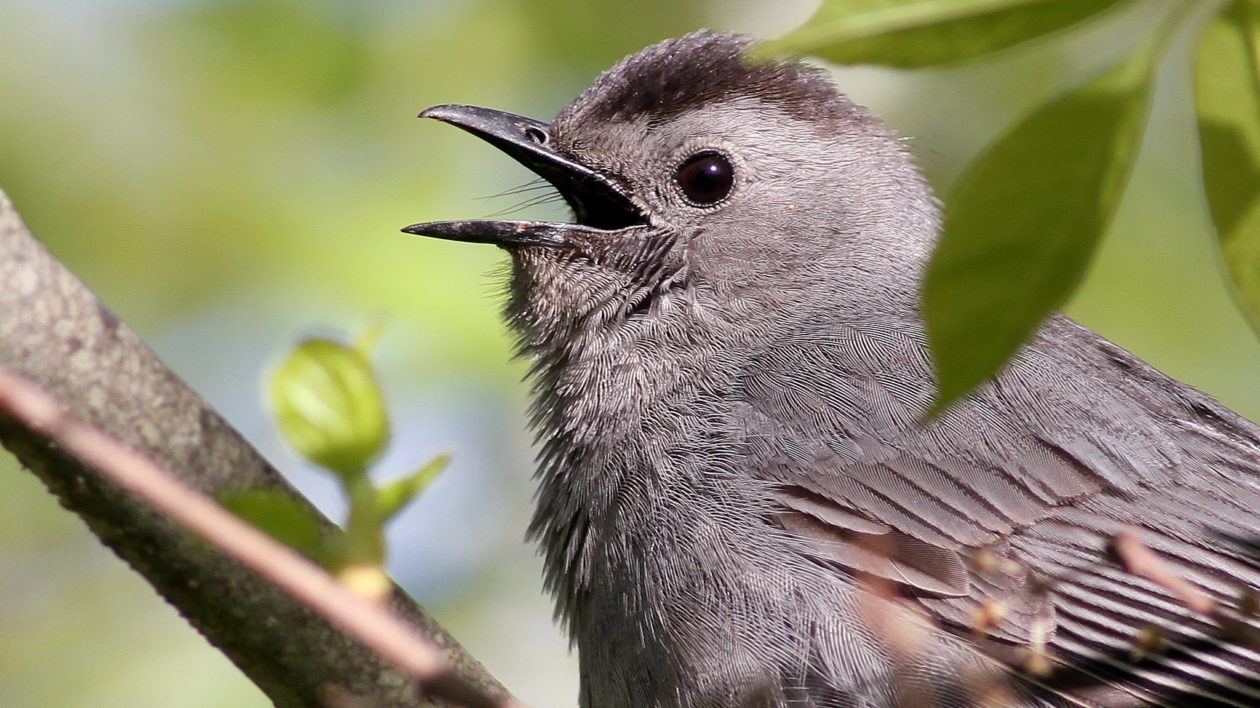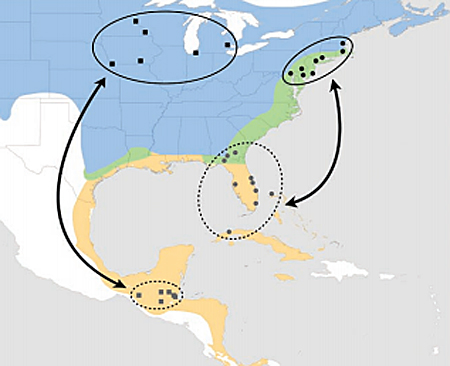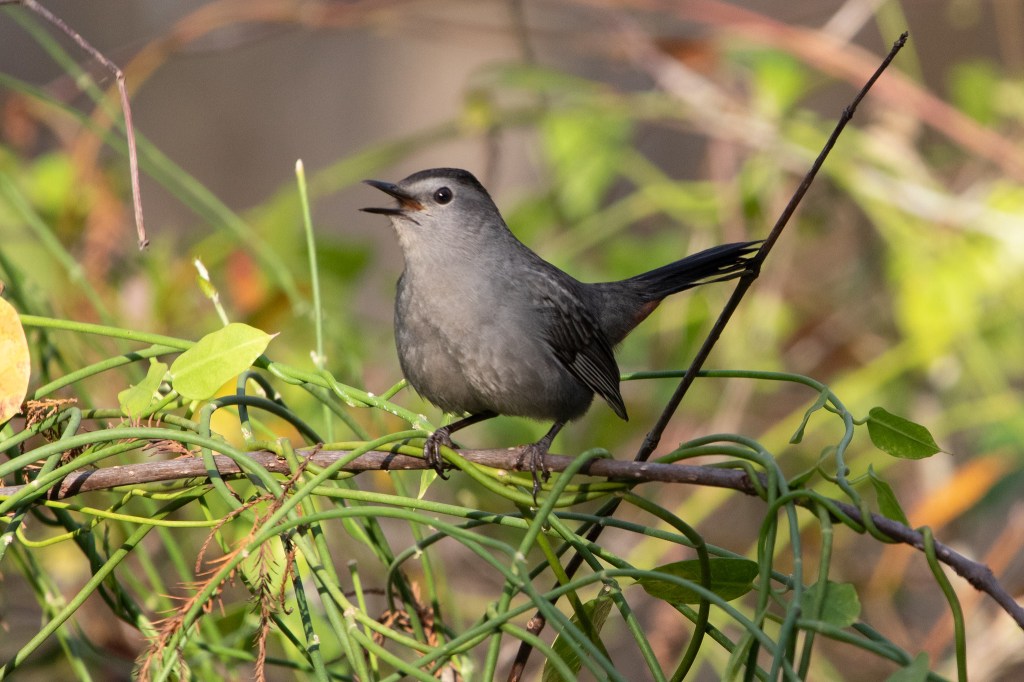Consider the gray catbird: the tropical long-distance migrant that may well be nesting in your backyard this summer.
Gray catbirds are common, so you may not pay them much attention. But look into the research, and you’ll find that this backyard bird is full of surprises. Let’s take a closer look.
As I write this, a gray catbird is singing in my backyard.
It arrived here in New Jersey several weeks ago and may already be building a nest with its mate somewhere in the neighborhood.
I am wondering where my catbird spent its winter – and whether this is the very same catbird that was in my yard last summer. Research on catbirds can help answer these questions.
Every spring, dozens of species of migrant songbirds make their way north from the tropics to settle into nesting habitats across North America. Indeed, half of all North American birds spend their winters south of the U.S. border – from Mexico through South America.
Most of these species are habitat specialists and we might see them in our backyards only briefly during migration as they make their way to more remote places.

The gray catbird, on the other hand, is a migrant from the tropics that is quite happy to claim a breeding territory in a wide variety of shrubby habitats, including suburban backyards.
The catbird singing in your backyard this spring is likely the same one that was there last year. Individual catbirds (and numerous other species) return to the same habitat patch to nest year after year, as long as they are fortunate enough to survive from one season to the next. Studies have shown a roughly 60 percent annual survival rate for catbirds.
If your backyard catbird has a lucky streak, you could see the same bird coming back for many seasons. The longevity record for a catbird is 17 years, 11 months.
This nearly 18-year-old bird was caught and banded as a young of the year in Maryland and miraculously encountered again by banders those many years later in New Jersey.
Banding can confirm the age of birds and also confirm that the bird in your backyard this year is the same one that was there last year.
Participants in programs like Neighborhood Nestwatch can observe their backyard catbirds wearing unique combinations of colored leg bands. These identify each bird as an individual and can be viewed with binoculars. For this project, researchers and participants alike can make observations on the identity and longevity of their catbirds.
Catbirds nest in 46 of the lower 48 United States and across southern Canada. They spend the winter across an equally broad area. A proportion stay in the U.S., where they primarily occupy the Gulf Coast and Florida. Some hearty individuals hang in there as far north as New Jersey.

Others go further south to the tropics – to the forests of Mexico, the Caribbean and Central America. There, they share the woods with jaguar, tapir, fer-de-lance and toucans.
Catbirds return to the same site on the wintering grounds every year as well. Your backyard catbird might spend the winter in the shadow of Mayan ruins in Guatemala or perhaps in the Florida Everglades.

We can make an educated guess on where your backyard catbirds spend the winter thanks to a recent analysis of banding records along with the use of tracking devices.
What this work tells us is that if a catbird breeds in the upper Midwest, it is more likely to be spending the winter in Central America. If it nests in the mid-Atlantic and New England, your catbird is likely spending the winter in Florida or the Caribbean.
As more studies like this one are carried out, we will have a further refined picture of “migratory connectivity” between nesting and winter sites. And we will be able to make even better guesses about where our backyard catbird might be next winter.
“A Few Raisins Give Him the Greatest Delight”
If you want to kick things up a notch for your backyard catbirds this summer, in addition to providing water, you can also offer them fruit.
As the poet Mary Oliver observes in her poem “Catbird”: “But a few raisins give him the greatest delight.”
One of the pleasures of a birding holiday in the tropics is watching birds at fruit feeders. After hours of seeking difficult-to-see skulking birds of the undergrowth and fast-flitting birds of the high tree tops, birding respite can be found at lodges and cafes that maintain fruit feeders for birds. Dozens of species of brightly colored birds come into easy view to eat banana, papaya and citrus at close range.
Catbirds bring a bit of this culture back with them from the tropics and are among the few birds at our northern latitudes that will readily eat soaked raisins, sliced orange and even grape jelly.
Back to my well-fed catbird. Is he the same bird as last year? Without banding him, I can’t know for sure. But I do know that he will do everything within his power to return here.

And return from where?
Maybe it is time to combine science with imagination. The science tells me that he wintered somewhere in Florida or the Caribbean.
But for better spatial resolution, my imagination is saying the Zapata Swamp of Cuba. Listen to what he sounds like there (in the audio file) … and then listen for the catbird in your yard!




I had catbirds in my yard this summer (2020) and after Storm Isaias went through….they are no longer here? Is there a reason this happened? Strangest thing, because they’ve been coming to my yard for the past few years.
My catbirds have been coming to my Northern New York yard for 30 Years…I bought my home in 1991 and next Summer will be 30 Years..They nest in the same exact brushes and have never changed..I enjoy them as much as anything and it’s now August and I’m even sad that they will be leaving,,,I pray to God that my Catbirds and myself live another year so we can see each other again…Sorry for acting like a baby but that’s how I feel..Thank you
I have a catbird in my yard for the first time ever. It tries land and feed but the robins that feed in the tomato patch chase him off no matter what. Is there a way I can get the two to co exhist? I don’t want the robins to leave but I’m getting more than a little upset with them over this.
Thank you so much Joe for your info about gray Catbirds. I had no idea they migrated so far and can live so long. Good to know. During this pandemic, I have become more aware of the habits of the catbirds in my yard. In particular, the fact that they love to take baths! They totally let loose with their flapping and going under the water, then jumping out, then jumping back in again! Such a pleasure to watch them during the really hot days. I feel honored to have them return to my yard here in Delaware County PA.
Thank you for the great visual stroll. I’ve seen many of them here in the suburbs of Chicago. Betting you’re a great person to go birdwatching with?
Joe, I have had catbirds in my yard for three years now. They are very attentive to everything I do in the yard. I can’t change anything without their consent. The last couple of days however, a new behavior has emerged. The bird catches a bug or worm and then presents it to me, noisily and while hopping from branch to branch. Today two catbirds were definitely trying to get my attention with various bugs and worms. I especially noticed in one area of my yard. Was this to distract me from their nest nearby?
Andrew, I’ve suspected the catbirds in my front yard try to distract me when I’m near the burning bush that they nest in. I never noticed them offering me anything. They flutter their wings which look too tiny to fly with or get quite close and hop around in the myrtle “tree”.
I live in Iowa and have a large flower garden in front of my home. I believe that I have a Catbird that has returned and will actually land in the garden when I am watering in the mornings. The bird doesn’t appear as frightened as some and actually gets very close in proximity to where I am working. I have seen the mate as well and I find them entertaining.
I live in a townhouse in downtown Philadelphia. I have several very tame cat birds that return every spring (early May). They go for the berries I set out for them on my patio table – often while I’m sitting only a foot or two away. On two occasions they’ve even flown into my dining room when I left the screen door open by mistake. In both cases I simply spoke gently to my ‘visitor’, pointed to the doorway, and he/she immediately flew out, back to the patio, awaiting their next treat!
Why is my catbird pecking at all my windows? Does it see a reflection and think it’s another bird?
Thank you for the interesting information on the grey catbird. I got to see one up close, which is how I identified it. It is hard to imagine this little bird would fly a thousand miles to come back here year after year. All that way. Amazing.
Last spring my husband fed a pair of catbirds blue berries cut in half. They became almost tame. He would whistle for them and would place pieces of blue berry closer and closer on the deck rail until they were almost eating out of his hand. I have just seen a pair this year that seem to be looking on the table as if they are remembering last year. I must buy some blueberries!
The Cat Birds arrive here in my yard and neighborhood May 7th. What a delight it is to hear them return to Southeastern Massachusetts with their lovely happy song. They are my favorite birds, along with the Mockingbird. By July there are no male Cat Birds to be heard or seen, only the female, who meows. I can’t figure out were all of the males disappear to. I suspect that the hawks have something to do with their disappearance, drawn to the male Cat Birds song. My heart sinks when the male Cat Bird is no longer singing to me his beautiful song.
We have what we believe is a catbird fluttering into our windows for several hours every morning. However, we live in Estes Park, Colorado at 8,000 feet above sea level. He/she is very persistent in this fruitless pursuit. We have lived in our house for 8 years and have never seen a catbird in the area. Is this one lost?
I have gotten close with the catbirds in our yard over the last few years, one thing I have found
is they are very fond of pistachios, we have been using “Feathered Friend” shell-less select
seed from “Agway”with has a good amount of the nut in their bags. Our catbirds comes when I’m in
the yard and sit squawking on a branch, I’ll flick a few broken up nuts in their vicinity, he’ll come down from the branch
and devour them and take off. It’s a ritual that has played out for the last few seasons.
Not sure how many people are aware of this trait. Curious to have your feedback. We live in the
woods of East Quogue, New York.
A male catbird has returned to our woods clearing each of the last three summers. I know it is the same one as he seeks me out as I garden, sometimes sitting only three feet from me as I weed . watching for insects and this year, even being so bold as to alight if ever so briefly on my fingers to snatch crickets from my hand. When he and his mate were feeding nestlings, he would even alight on the small glass table next to my chair as I had my morning coffee. I am very fond of this catbird, miss him when he leaves and celebrate his return in April. It is now late August and it appears he is molting. Or could this be one of his fledged nestlings who has learned of the gardener who hands out crickets?